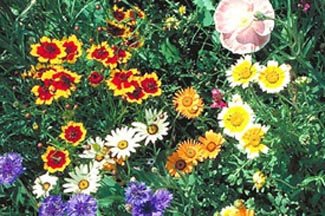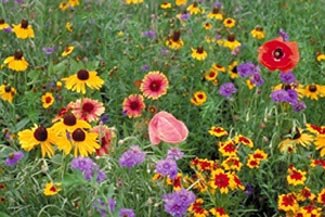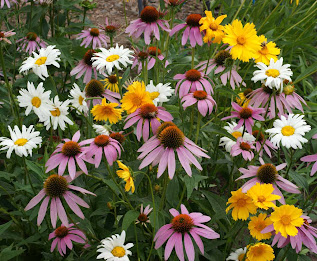 When Planting any type of garden you must first prepare the site.
When Planting any type of garden you must first prepare the site.1. Clear the area of all unwanted vegetation, like weeds and grasses with either or both methods:
A. Use Round-Up* or like glyphosate herbicide. If you have a lot of weed seeds present, wait 1-2 weeks, water, let the weed seeds germinate, and then spray again. Wait 3-4 weeks before planting the wildflower seeds. Shrubs or trees, and bulbs will not interfere with wildflower growth, but will be harmed by herbicides
B. Till the ground to a 3-6 inch depth, removing all vegetation. Rake the area to the desired final smoothness.
2. Measure the square footage of the area. Order the amount of seed for the required square footage.
3. Divide the amount of the seed and garden area into 4 equal parts. This division of area & seed assures equal coverage of the seed product.
4. Broadcast the seed, either by hand (best for areas under 1000 sq. ft.), or with a handheld broadcaster for larger areas. Be aware that seed size varies greatly. A lupine seed is as large as a grape seed, poppy seeds are fine as ground pepper. You may want to use clean, dry sand as a carrier at a 1 part seed to 1 part sand.
5. Rake by hand lightly to assure a soil/seed contact.
6. For a fall planting, sow seeds after the fall equinox, and before the ground is frozen and no longer workable. DO NOT WATER IN FALL. Fall planting is extremely useful on sites where irrigation will not be used, as the winter and spring precipitation should be adequate for germination.
7. To plant in the spring, sow seeds three weeks before the last "killer frost". Water in the spring if dry for 4-6 weeks or until the new seedlings are viable.
8. Continuing removal of all weeds and undesirable grass is a must for an optimal display of wildflowers.
9. Mow once in the fall to 4-6 inches. Leave debris on the ground, as this is your seed reservoir and will reseed the area. You can lightly rake the large debris in the spring, taking care not to injure emerging seedlings.
10. Unless you have extremely poor soils, fertilization of 5-10-10 ratio can be used. Over fertilization promotes foliage and weed growth. Organic materials added to the soil will enhance the nutrient level and structure of the soil without over fertilization. For more in-depth information please refer to General Planting and Cultural Information.
* Please use extreme caution when using any herbicides. Follow the manufacture's recommendations for application.














0 comments:
Post a Comment